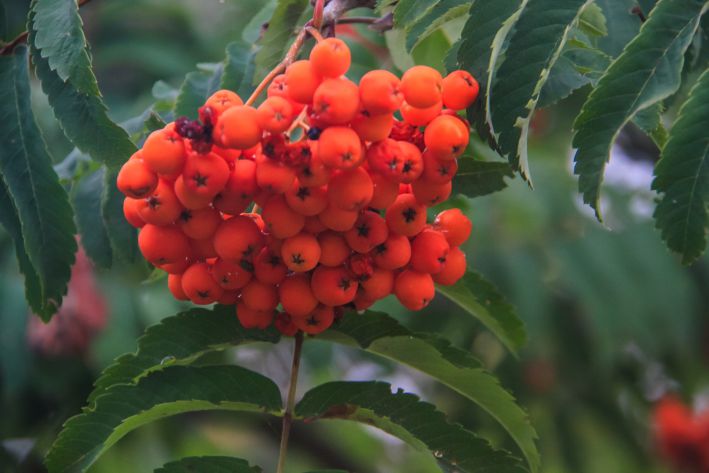In late autumn, when the trees shed their leaves and the forest stands bare and sad, the rowan tree appears in all its glory.
Its main pride is, of course, the clusters blazing with crimson against the background of dark, lacy foliage.
Anastasia Kovrizhnykh, an expert of the online publication "BelNovosti", an agronomist and landscape designer, spoke about the benefits of rowan and its fruits.
Rowan berries, which, by the way, are more correctly called apples, are rich in vitamins P and K, carotene, organic acids, pectins and other valuable compounds.
Therefore, they can be used as a multivitamin. But, alas, the appearance of the tree has long ceased to surprise anyone, and only birds are interested in its berries.

Our ancestors would certainly have been surprised by such an attitude towards their nurse, fortune teller, protector and healer.
Rowan as a weather forecaster
At the beginning of the rowan blossoming, we can safely say that the earth has warmed up to 12-15 degrees.
An "awakened" tree is a sign that the optimal time for sowing and planting seedlings has arrived. Gardeners of past generations say that there is no need to worry about return frosts. An abundance of berries on the trees, on the contrary, predicts a harsh, protracted winter.
Rowan wildings for grafting
Red rowan trees are an excellent rootstock. They cope well with severe frosts and get along with nearby groundwater.
Crops grafted on rowan develop "compact" and cope well with the harvest load. The combination of rowan and pear is very interesting.
Each part of the duo continues to live according to its own schedule: when the pear blossoms, the rowan buds are just opening. Usually, an adult tree is used as a rootstock, and pear cuttings are grafted to the skeletal branches.
You can also graft chokeberry, hawthorn, and Chinese apple onto wild rowan trees.
Rowan as a powerful amulet
Since ancient times, the tree has been attributed with magical powers.
In villages they still believe that a rowan tree must grow near the house to protect the owners from all sorts of troubles and thieves. If the tree begins to wither without any reason, it is a bad sign.
Fire shield
A tree with a lush crown does not burn well. For this reason, trees used to grow between houses, they were often found near baths. This reduced the likelihood of fire spreading when a fire broke out.
Natural preservative
In the food industry, sorbic acid is widely used as a preservative. This compound has a broad antimicrobial effect. It has a negative effect on the growth of fungi.
By the way, sorbic acid was first obtained in the 19th century from rowan berries. Its berries are recommended to be included in winter preparations.
As rowan berries ripen, the amount of preservative acid in them increases.
The substance is also contained in the leafy part of the tree; it is no wonder that our grandmothers and great-grandmothers combined sauerkraut in barrels with rowan branches.
Valuable wood
Rowan wood is used as a material for tool handles that are often subject to impact loads.
Such tools include hammers, shovels, rakes, scythes. And the owner's real pride is an axe with a rowan handle.
This will last a long time and, most importantly, will not spring. The best option for making handles is dead wood, dried out at the root.
Purifies water without boiling
Rowan berries and branches make water drinkable and prevent its blooming for a long time. This property of the tree was especially appreciated by travelers.
To get clear water from muddy water, fresh branches are added to the container at a rate of 5 pcs. per 1 liter of water. After 2-3 hours of settling, the water becomes usable for at least rinsing dishes and washing.
Will save the harvest
Rowan preserves the harvest during winter storage. Before sending potatoes and root crops to storage, chopped leaves are poured into each box.
Then put the branches. Fern leaves, goutweed, mint, tansy are suitable for this. It is only important to remember about the helper plants in time and to take care of their preparation in advance.
Medicinal raw materials
Rowan berries are used for vitamin deficiency, anemia, high cholesterol, liver and kidney diseases, and metabolic disorders. The berries are collected after the first frosts, when they lose their bitterness.
Frozen rowan berries can be stored in the cold until spring, but usually they are immediately used to make preserves: jam, marmalade, juice, vinegar, sauce.
Dried berries are used to make vitamin teas. If you decide to dry rowan berries in the oven, set the temperature to no more than 50-60 degrees. Drying takes only 2-4 hours.
Important: consuming rowan berries in large quantities is contraindicated for people with increased acidity of gastric juice and a tendency to form blood clots.









